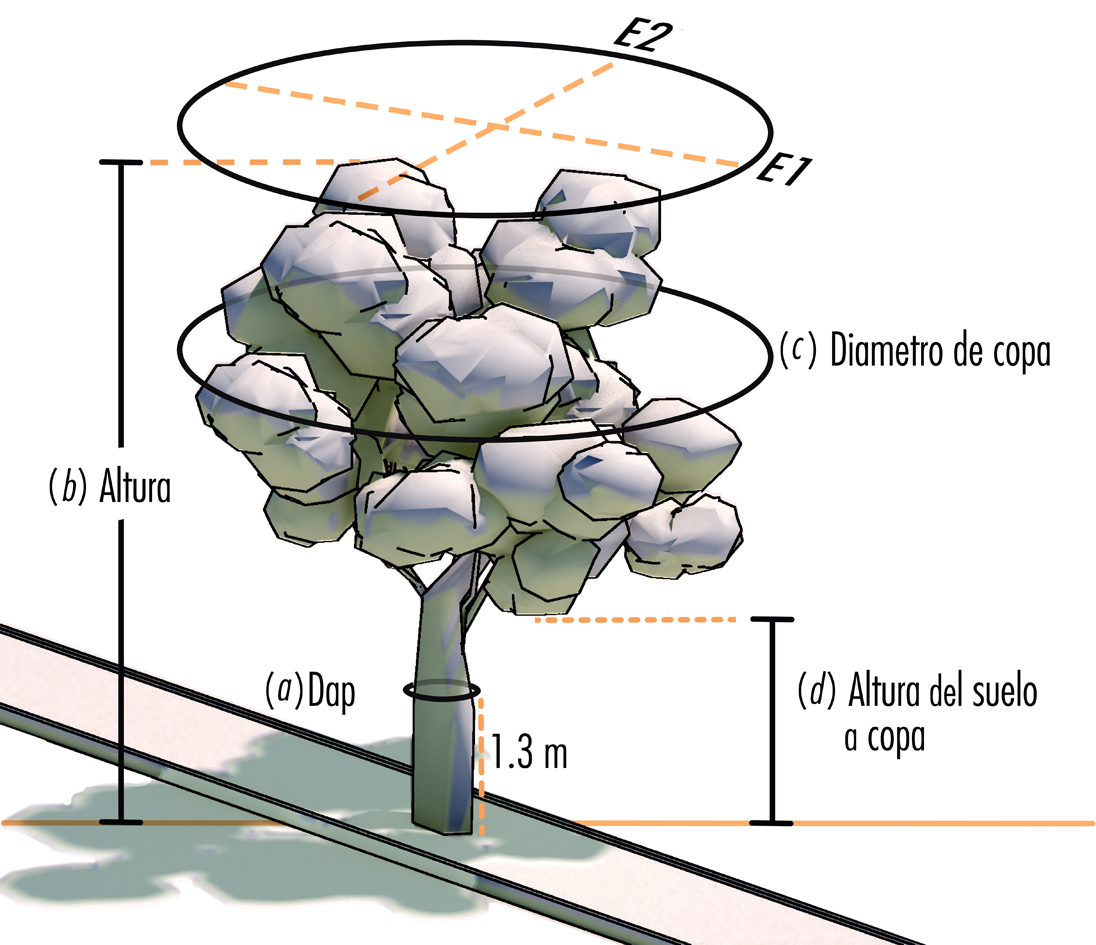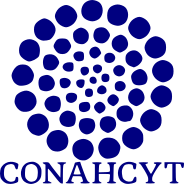Variación morfométrica y espacial urbana de tres especies arbóreas en función del ancho de camellón en calles de la ciudad de San Luis Potosí, México
DOI:
https://doi.org/10.18387/polibotanica.60.12Palabras clave:
arbolado urbano, morfometría arbórea, ancho de camellón, servicios ambientales, configuración urbanaResumen
Las condiciones físicas y ambientales del sistema urbano, generalmente, se contraponen al desarrollo de las especies vegetales. De este conjunto, sobresalen los árboles urbanos tanto por sus dimensiones como por las funciones y beneficios ambientales. Dentro de la amplia gama de hábitats para los árboles en una ciudad el de mayor exposición a los agentes urbanos es el de calle, siendo más frecuente el de banqueta o camellón. Así, en el presente estudio la interrogante fue determinar cómo la variación del ancho de camellón puede tener efecto en la morfometría de tres especies de árboles urbanos. Se evaluaron las variables alométricas del diámetro a la altura del pecho (DAP), altura del árbol (Aa) y área de proyección de copa (APC) de árboles de fresno, laurel de la India y pirul en la ciudad de San Luis Potosí, México. También, se usó el programa libre de i-TREE Eco para estimar de manera indirecta el valor de importancia, el área foliar y el secuestro bruto de carbono de cada especie arbórea. Además, se observó la orientación de la calle, la proporción altura de edificio – ancho de calle (AE-AC) y el tipo de tránsito vial en relación con el ancho de camellón. En los resultados, el pirul mostró los valores más altos de alometría y área foliar, pero sin distinción por un tipo de camellón. En laurel de la India la respuesta indicó valores medios y preferentemente en camellón mediano y estrecho. Mientras tanto, fresno tuvo los valores más bajos de morfometría y los más altos de secuestro bruto de carbono, pero con mayor respuesta en camellón amplio. Por lo tanto, la morfometría fue diferencial en función del ancho de camellón, además de un alto nivel de adaptación del pirul y mayores servicios ambientales del fresno. Estos hallazgos sugieren que la configuración urbana y la respuesta morfológica pueden ser de utilidad en la planeación de infraestructura verde en las calles buscando aumentar los beneficios ambientales para la ciudad
Referencias
Ahmadi Venhari, A., Tenpierik, M., & Taleghani, M. (2019). The role of sky view factor and urban street greenery in human thermal comfort and heat stress in a desert climate. Journal of Arid Environments, 166, 68–76. https://doi.org/10.1016/j.jaridenv.2019.04.009
Ajayi, E. (2021). Assessment of Carbon Sequestration Potential of some Selected Urban Tree Species. https://doi.org/10.1101/2021.08.19.457022
Alberti, M., Palkovacs, E. P., Roches, S. Des, De Meester, L., Brans, K. I., Govaert, L., Grimm, N. B., Harris, N. C., Hendry, A. P., Schell, C. J., Szulkin, M., Munshi-South, J., Urban, M. C., & Verrelli, B. C. (2020). The Complexity of Urban Eco-evolutionary Dynamics. En BioScience (Vol. 70, Número 9, pp. 772–793). Oxford University Press. https://doi.org/10.1093/biosci/biaa079
Ayuntamiento de San Luis Potosí, S. L. P. (2002). Reglamento de parques y jardines públicos del municipio libre de San Luis Potosí, S.L.P.
Benavides-Meza, H. M., & Young-Fernández Grandizo, D. (2012). Estructura del arbolado y caracterización dasométrica de la segunda sección del Bosque de Chapultepec. Madera Bosques, 18(2), 51–71. https://doi.org/10.21829/myb.2012.182352
Blanchard, E., Birnbaum, P., Ibanez, T., Boutreux, T., Antin, C., Ploton, P., Vincent, G., Pouteau, R., Vandrot, H., Hequet, V., Barbier, N., Droissart, V., Sonké, B., Texier, N., Kamdem, N. G., Zebaze, D., Libalah, M., & Couteron, P. (2016). Contrasted allometries between stem diameter, crown area, and tree height in five tropical biogeographic areas. Trees - Structure and Function, 30(6), 1953–1968. https://doi.org/10.1007/s00468-016-1424-3
Bourbia, F., & Boucheriba, F. (2010). Impact of street design on urban microclimate for semi arid climate (Constantine). Renewable Energy, 35(2), 343–347. https://doi.org/10.1016/j.renene.2009.07.017
Cedano Billini, S. C. (2013). Análisis de la radiación en calles de latitud 20°N [Máster Arquitectura, Energía y Medio Ambiente]. Escuela Técnica Superior de Arquitectura de Barcelona.
Chatziathanasiou, S., Kitikidou, K., & Milios, E. (2023). Allometries of Acer negundo for a better space management in two cities of northeastern Greece. Folia Oecologica, 50(1), 89–96. https://doi.org/10.2478/foecol-2023-0008
Chatziathanasiou, S., Kitikidou, K., & Milios, E. (2024). Crown Width–Tree Height Models for Magnolia grandiflora, Prunus cerasifera, and Acer negundo Growing in Cities in Northeastern Greece. Land, 13(10). https://doi.org/10.3390/land13101579
Chatzidimitriou, A., & Axarli, K. (2017). Street Canyon Geometry Effects on Microclimate and Comfort; A Case Study in Thessaloniki. Procedia Environmental Sciences, 38, 643–650. https://doi.org/10.1016/j.proenv.2017.03.144
City of Melbourne. (2010). Landscape treatment policy for nature strips and medians in streets, avenues and boulevards.
Cox, S. (2011). Urban trees: A practical management guide. . The Crowood Press.
Czaja, M., Kołton, A., & Muras, P. (2020). The complex issue of urban trees-stress factor accumulation and ecological service possibilities. En Forests (Vol. 11, Número 9). MDPI AG. https://doi.org/10.3390/F11090932
Dahlhausen, J., Biber, P., Rötzer, T., Uhl, E., & Pretzsch, H. (2016). Tree species and their space requirements in six urban environments worldwide. Forests, 7(6). https://doi.org/10.3390/f7060111
Díaz-Porras, D. F., Gaston, K. J., & Evans, K. L. (2014). 110 Years of change in urban tree stocks and associated carbon storage. Ecology and Evolution, 4(8), 1413–1422. https://doi.org/10.1002/ece3.1017
DOT. (2015). Planted Raised Median Design Guidelines.
Drolen, J., Brandt, L., Wei, Y., & Dybzinski, R. (2023). Modeling Management-Relevant Urban Forest Stand Characteristics to Optimize Carbon Storage and Sequestration. Forests, 14(11). https://doi.org/10.3390/f14112207
Du, H., Bao, Z., & Zhou, F. (2024). Carbon Sequestration of Common Garden Tree Species under the Carbon Neutrality Target in East China. Forests, 15(10). https://doi.org/10.3390/f15101692
Eisenman, T. S., Coleman, A. F., & LaBombard, G. (2021). Street Trees for Bicyclists, Pedestrians, and Vehicle Drivers: A Systematic Multimodal Review. En Urban Science (Vol. 5, Número 3). MDPI. https://doi.org/10.3390/urbansci5030056
Fang, K., Wang, X., Zhang, W., Zhang, Z., Xie, Y., Chen, L., Zhu, G., & Furuya, N. (2021). Characteristics of space network system formed by the constituent elements in urban streets: Tianzifang in Shanghai as a case study. Journal of Asian Architecture and Building Engineering, 20(6), 627–639. https://doi.org/10.1080/13467581.2020.1803078
FAO. (2004). Inventario forestal nacional. Manual de campo. www.fao.org/forestry
Fatimah, H., Farooq, S., Anwar, T., Qureshi, H., Hashmi, F., Ahmad, T., Ullah, N., Munazir, M., Naseem, M. T., & Soufan, W. (2024). Assessment of growth, biomass, and carbon sequestration potential of urban tree species in greenbelts. BMC Plant Biology, 24(1). https://doi.org/10.1186/s12870-024-05935-3
Feng, X., Wen, H., He, M., & Xiao, Y. (2023). Microclimate effects and influential mechanisms of four urban tree species underneath the canopy in hot and humid areas. Frontiers in Environmental Science, 11. https://doi.org/10.3389/fenvs.2023.1108002
Findley, D. J. (2016). Part 4 - Highway Geometric Design. En D. J. Findley, B. J. Schroeder, C. M. Cunningham, & T. H. Brown (Eds.), Highway Engineering: Planning, Design, and Operations (pp. 167–253). Butterworth-Heineman. https://doi.org/10.1016/B978-0-12-801248-2.00004-6
Fitzpatrick, K., Wooldridge, M. D., & Blaschke, J. D. (2004). Urban intersection design guidece.
Gleason, S. M., & Ares, A. (2004). Photosynthesis, carbohydrate storage and survival of a native and an introduced tree species in relation to light and defoliaton. Tree Physiology, 24, 1087–1097.
Guo, C., Hu, Y., Qin, J., Wu, D., Xu, L., & Wang, H. (2024). Comparison of Crown Volume Increment in Street Trees among Six Cities in Western Countries and China. Horticulturae, 10(3). https://doi.org/10.3390/horticulturae10030300
Guzzetti, F., Anyabolu, K. L. N., D’Ambrosio, L., & Marchetti, G. (2019). Built environment: Modelling the urban space. ISPRS Annals of the Photogrammetry, Remote Sensing and Spatial Information Sciences, 42(2/W11), 595–600. https://doi.org/10.5194/isprs-Archives-XLII-2-W11-595-2019
Heisler, G. (1986). Energy Savings with Trees. Arboriculture & Urban Forestry, 12(5), 113–125. https://doi.org/10.48044/jauf.1986.026
Hernández-López, P., Martínez-Trinidad, T., dela Rosa, P. H., Mohedano-Caballero, L., & de Guillén, M. J. G. (2023). Ecological characterization of trees at Molino de Flores Netzahualcóyotl National Park. Revista Chapingo, Serie Ciencias Forestales y del Ambiente, 29(3), 93–108. https://doi.org/10.5154/r.rchscfa.2023.01.002
Hui, L. C., Jim, C. Y., & Zhang, H. (2020). Allometry of urban trees in subtropical Hong Kong and effects of habitat types. Landscape Ecology, 35(5), 1143–1160. https://doi.org/10.1007/s10980-020-01006-8
IMPLAN de Hermosillo. (2017). Manual de lineamientos de Diseño de Infraestructura Verde para Municipios Mexicanos.
IMPLAN SLP. (2021). Distritos del PDCUCP-SLP. Mapa 61. En Programa de Desarrollo Urbano de Centro de Población de San Luis Potosí, SLP.
INEGI. (2013). Diccionario de datos topográficos escala 1: 50 000 versión 2.
INEGI. (2020a). Inventario Nacional de Viviendas. archivo SHP.
INEGI. (2020b). Marco Geoestadístico del Censo de Población y Vivienda. archivo SHP.
Kim, J., Kang, Y., Kim, D., Son, S., & Kim, E. J. (2024). Carbon Storage and Sequestration Analysis by Urban Park Grid Using i-Tree Eco and Drone-Based Modeling. Forests, 15(4). https://doi.org/10.3390/f15040683
Kjelgren, R. K., & Clark, J. R. (1992). Photosynthesis and leaf morphology of Liquidambar styraciflua L. under variable urban radiant-energy conditions. Int J Biometeorol, 36, 165–171.
Langenheim, N., White, M., Tapper, N., Livesley, S. J., & Ramirez-Lovering, D. (2020). Right tree, right place, right time: A visual-functional design approach to select and place trees for optimal shade benefit to commuting pedestrians. Sustainable Cities and Society, 52. https://doi.org/10.1016/j.scs.2019.101816
Li, H., Zhao, Y., Wang, C., Ürge-Vorsatz, D., Carmeliet, J., & Bardhan, R. (2024). Cooling efficacy of trees across cities is determined by background climate, urban morphology, and tree trait. Communications Earth and Environment, 5(1). https://doi.org/10.1038/s43247-024-01908-4
Liang, D., & Huang, G. (2023). Influence of Urban Tree Traits on Their Ecosystem Services: A Literature Review. En Land (Vol. 12, Número 9). Multidisciplinary Digital Publishing Institute (MDPI). https://doi.org/10.3390/land12091699
Lin, W., Guo, W., Huang, S., Wei, J., Wei, Y., Zhou, J., & Lai, C. (2024a). Effects of growth space limitation on allometry of Ficus spp. In urban habitats. Journal of Cleaner Production, 471, 143413. https://doi.org/https://doi.org/10.1016/j.jclepro.2024.143413
Lin, W., Guo, W., Huang, S., Wei, J., Wei, Y., Zhou, J., & Lai, C. (2024b). Effects of growth space limitation on allometry of Ficus spp. In urban habitats. Journal of Cleaner Production, 471. https://doi.org/10.1016/j.jclepro.2024.143413
Livesley, S. J., McPherson, E. G., & Calfapietra, C. (2016). The Urban Forest and Ecosystem Services: Impacts on Urban Water, Heat, and Pollution Cycles at the Tree, Street, and City Scale. Journal of Environmental Quality, 45(1), 119–124. https://doi.org/10.2134/jeq2015.11.0567
Mansour, A. I., & Aljamil, H. A. (2022). Investigating the Effect of Traffic Flow on Pollution, Noise for Urban Road Network. IOP Conference Series: Earth and Environmental Science, 961(1). https://doi.org/10.1088/1755-1315/961/1/012067
Martínez-Millán, M., & Cevallos-Ferriz, S. R. S. (2005). Arquitectura foliar de Anacardiaceae. Revista Mexicana de Biodiversidad, 76(2). https://doi.org/10.22201/ib.20078706e.2005.002.308
Mballo, S., Herpin, S., Manteau, M., Demotes-Mainard, S., & Bournet, P. E. (2021). Impact of well-watered trees on the microclimate inside a canyon street scale model in outdoor environment. Urban Climate, 37. https://doi.org/10.1016/j.uclim.2021.100844
McPherson, E. G., van Doorn, N. S., & Peper, P. J. (2016). Urban tree database and allometric equations. En Forest Service Research Data Archive. Forest Service Research Data Archive. https://doi.org/10.2737/RDS-2016-0005
McPherson, G., & Simpson, J. R. (1995). Shade trees as a demand-side resource. Home Energy, 12(3).
Morakinyo, T. E., Lau, K. K. L., Ren, C., & Ng, E. (2018). Performance of Hong Kong’s common trees species for outdoor temperature regulation, thermal comfort and energy saving. Building and Environment, 137, 157–170. https://doi.org/10.1016/j.buildenv.2018.04.012
Mullaney, J., Lucke, T., & Trueman, S. J. (2015). A review of benefits and challenges in growing street trees in paved urban environments. En Landscape and Urban Planning (Vol. 134, pp. 157–166). Elsevier B.V. https://doi.org/10.1016/j.landurbplan.2014.10.013
National Association of City Transportation Officials. (2012). Urban street design guide.
Noyola-Medrano, M. C., Ramos-Leal, J. A., Domínguez-Mariani, E., Pineda-Martínez, L. F., López-Loera, H., & Carbajal, N. (2009). Factores que dan origen al minado de acuíferos en ambientes áridos caso Valle de San Luis Potosí. Revista Mexicana de Ciencias Geológicas, 26(2), 395–410.
ODOT. (1996, febrero). Medians. Discussion Paper No. 4, 41.
Oke, T. R. (1988). Street Design and Urban Canopy Layer Climate. En Energy and Buildings (Vol. 11).
Osseni, A. A., Gbesso, G. H. F., & Assongba, Y. F. (2022). Phytodiversity, structure and carbon sequestered by avenue trees in the Municipality of Sèmè-Podji, Southern Benin. International Journal of Biological and Chemical Sciences, 16(6), 2857–2868. https://doi.org/10.4314/ijbcs.v16i6.30
Pasiecznik, N. (2022). Fraxinus uhdei (tropical ash). CABI Compendium. https://doi.org/10.1079/cabicompendium.24559
Paz-Kagan, T., Zaady, E., Shachak, M., & Karnieli, A. (2016). Transformation of shrublands to forests: The role of woody species as ecosystem engineers and landscape modulators. Forest Ecology and Management, 361, 257–268. https://doi.org/10.1016/j.foreco.2015.11.021
Peper, P. J., Mcpherson, E. G., & Mori, S. M. (2001). PREDICTIVE EQUATIONS FOR DIMENSIONS AND LEAF AREA OF COASTAL SOUTHERN CALIFORNIA STREET TREES. En Journal of Arboriculture (Vol. 27, Número 4).
Pereira, M. P., Rodrigues, L. C. de A., Corrêa, F. F., de Castro, E. M., Ribeiro, V. E., & Pereira, F. J. (2016). Cadmium tolerance in Schinus molle trees is modulated by enhanced leaf anatomy and photosynthesis. Trees - Structure and Function, 30(3), 807–814. https://doi.org/10.1007/s00468-015-1322-0
Pires, M. F., Pereira, M. P., de Castro, E. M., Barbosa, S., & Pereira, F. J. (2015). Micromorfometria foliar de Schinus molle L. (Anarcadiaceae) em diferentes alturas na copa. Cerne, 21(1), 17–25. https://doi.org/10.1590/01047760201521011530
Pretzsch, H., Biber, P., Uhl, E., Dahlhausen, J., Rötzer, T., Caldentey, J., Koike, T., van Con, T., Chavanne, A., Seifert, T., Toit, B. du, Farnden, C., & Pauleit, S. (2015). Crown size and growing space requirement of common tree species in urban centres, parks, and forests. Urban Forestry and Urban Greening, 14(3), 466–479. https://doi.org/10.1016/j.ufug.2015.04.006
Rakowska, A., Wong, K. C., Townsend, T., Chan, K. L., Westerdahl, D., Ng, S., Močnik, G., Drinovec, L., & Ning, Z. (2014). Impact of traffic volume and composition on the air quality and pedestrian exposure in urban street canyon. Atmospheric Environment, 98, 260–270. https://doi.org/10.1016/j.atmosenv.2014.08.073
Ramírez-Albores, J., & Badano, E. (2013). Perspectiva histórica, sociocultural y ecológica de una invasión biológica: el caso del Pirúl (Schinus molle L., Anacardiaceae) en México (Boletín de la RLEEI - Actualmente Revista Bioinvasiones). 4, 4–15.
Ramírez-Albores, J. E., Avendaño-Gonzáles, M., & Badano, E. I. (2015, febrero). El Pirul, el árbol que vino del sur. CONABIO. Biodiversitas, 117, 6–11.
Rantzoudi, E. C., & Georgi, J. N. (2017). Correlation between the geometrical characteristics of streets and morphological features of trees for the formation of tree lines in the urban design of the city of Orestiada, Greece. Urban Ecosystems, 20(5), 1081–1093. https://doi.org/10.1007/s11252-017-0655-4
Rasoolzadeh, R., Mobarghaee Dinan, N., Esmaeilzadeh, H., Rashidi, Y., Marcu, M. V., & Sadeghi, S. M. M. (2024). Carbon Sequestration and Storage of Urban Trees in a Polluted Semiarid City. Forests, 15(9), 1488. https://doi.org/10.3390/f15091488
Ren, X., Zhang, G., Chen, Z., & Zhu, J. (2023). The Influence of Wind-Induced Response in Urban Trees on the Surrounding Flow Field. Atmosphere, 14(6). https://doi.org/10.3390/atmos14061010
Rodriguez-Valencia, A., & Ortiz-Ramirez, H. A. (2021). Understanding green street design: Evidence from three cases in the U.S. Sustainability (Switzerland), 13(4), 1–19. https://doi.org/10.3390/su13041916
Sanders, J. R., & Grabosky, J. C. (2014). 20 years later: Does reduced soil area change overall tree growth? Urban Forestry and Urban Greening, 13(2), 295–303. https://doi.org/10.1016/j.ufug.2013.12.006
Sanusi, R., Johnstone, D., May, P., & Livesley, S. J. (2017). Microclimate benefits that different street tree species provide to sidewalk pedestrians relate to differences in Plant Area Index. Landscape and Urban Planning, 157, 502–511. https://doi.org/10.1016/j.landurbplan.2016.08.010
SEDATU. (2019). Manual de calles: diseño vial para ciudades mexicanas.
Shashua-Bar, L., & Hoffman, M. E. (2003). Geometry and orientation aspects in passive cooling of canyon streets with trees. Energy and Buildings, 35, 61–68.
Singh, H., Yadav, M., Kumar, N., Kumar, A., & Kumar, M. (2020). Assessing adaptation and mitigation potential of roadside trees under the influence of vehicular emissions: A case study of Grevillea robusta and Mangifera indica planted in an urban city of India. PLoS ONE, 15(1). https://doi.org/10.1371/journal.pone.0227380
Srivanit, M., & Jareemit, D. (2020). Modeling the influences of layouts of residential townhouses and tree-planting patterns on outdoor thermal comfort in Bangkok suburb. Journal of Building Engineering, 30. https://doi.org/10.1016/j.jobe.2020.101262
Stewart, I. D., & Oke, T. R. (2012). Local climate zones for urban temperature studies. Bulletin of the American Meteorological Society, 93(12), 1879–1900. https://doi.org/10.1175/BAMS-D-11-00019.1
Stoffberg, G. H., van Rooyen, M. W., van der Linde, M. J., & Groeneveld, H. T. (2008). Predicting the growth in tree height and crown size of three street tree species in the City of Tshwane, South Africa. Urban Forestry and Urban Greening, 7(4), 259–264. https://doi.org/10.1016/j.ufug.2008.05.002
Suchocka, M., Swoczyna, T., Kosno-Jonczy, J., & Kalaji, H. M. (2021). Impact of heavy pruning on development and photosynthesis of Tilia cordata Mill. trees. PLoS ONE, 16(8 August). https://doi.org/10.1371/journal.pone.0256465
Swiecki, T. J., & Bernhardt, E. A. (2001). Guidelines for Developing and Evaluating Tree Ordinances Site Map. http://www.isa-arbor.com/tree-ord/
Takagi, M., & Gyokusen, K. (2004). Light and atmospheric pollution affect photosynthesis of street trees in urban environments. Urban Forestry & Urban Greening, 2(3), 167–171. http://www.elsevier-deutschland.de/ufug
Tan, X., Hirabayashi, S., & Shibata, S. (2021). Estimation of ecosystem services provided by street trees in Kyoto, Japan. Forests, 12(3). https://doi.org/10.3390/f12030311
Tejeda-Martínez, A., & Gómez-Azpeitia, G. (2015). Prontuario solar de México.
Tochaiwat, K., Phichetkunbodee, N., Suppakittpaisarn, P., Rinchumphu, D., Tepweerakun, S., Kridakorn Na Ayutthaya, T., & Sittisom, P. (2023). Eco-Efficiency of Green Infrastructure on Thermal Comfort of Outdoor Space Design. Sustainability (Switzerland), 15(3). https://doi.org/10.3390/su15032566
USDA Forest Service. (2017). i-Tree ECO Manual de toma de datos. www.itreetools.org
Vasagadekar, P. R., Gargate, A. V., Patil, Y. Y., & Raut, P. D. (2023). Carbon sequestration potential of trees from urban green spaces of Kolhapur city, Maharashtra, India. Environmental and Socio-Economic Studies, 11(3), 22–32. https://doi.org/10.2478/environ-2023-0014
Vaz Monteiro, M., Doick, K. J., & Handley, P. (2016). Allometric relationships for urban trees in Great Britain. Urban Forestry and Urban Greening, 19, 223–236. https://doi.org/10.1016/j.ufug.2016.07.009
Wan Ismail, W. N., Ja’afar, N. H., & Harun, N. Z. (2020). Physical qualities and elements of streets in the context of royal town in Malaysia. Rupkatha Journal on Interdisciplinary Studies in Humanities, 12(1), 1–13. https://doi.org/10.21659/rupkatha.v12n1.21
Yang, J., Zhang, M., Zhang, J., Lu, H., & Hauer, R. J. (2023). Allometric Growth of Common Urban Tree Species in Qingdao City of Eastern China. Forests, 14(3). https://doi.org/10.3390/f14030472
Zielonko-Jung, K., & Janiak, J. (2022). Trees as a solar control measure for southern-oriented street frontages. Analysis of a selected street model for a humid continental climate. Urban Ecosystems, 25, 111–119. https://doi.org/10.1007/s11252-021-01128-0/Published

Descargas
Publicado
Número
Sección
Categorías
Licencia
Derechos de autor 2025 POLIBOTÁNICA

Esta obra está bajo una licencia internacional Creative Commons Atribución-NoComercial-CompartirIgual 4.0.

Polibotánica por Departamento de Botánica de la Escuela Nacional de Ciencias Biológicas del Instituto Politécnico Nacional se distribuye bajo una Licencia Creative Commons Atribución-NoComercial-CompartirIgual 4.0 Internacional.



















